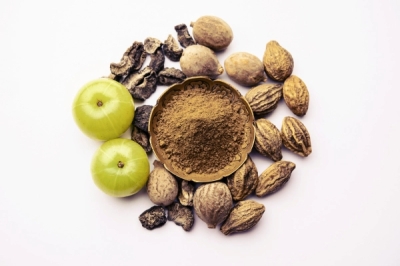Date: 26 Nov 2025
What is Triphala?
In Sanskrit, Triphala literally means “three fruits”. Behind this name stands a classical Ayurvedic combination of Amalaki (Amla), Bibhitaki and Haritaki – a formula traditionally described as gently supporting inner balance and the body’s natural cleansing processes.
The three fruits and their role in the Ayurvedic tradition
- Amalaki – also known as amla or Indian gooseberry – holds a special place in classical Ayurvedic texts. The fruit is rich in vitamin C and plant compounds and is traditionally associated with maintaining vitality. In Ayurveda, it is described as one of the important Rasayanas – substances which, according to tradition, nourish strength and resilience. Thanks to its multiple tastes (all except salty), Amalaki is considered harmonising for all three doshas – Vata, Pitta and Kapha.
- Babhitaki (Terminalia bellirica) is a fruit that the Ayurvedic tradition primarily connects with the Kapha dosha. It is attributed a supportive role in the body’s natural cleansing processes and the feeling of lightness. It is often recommended during transitional seasons – for example spring and autumn – when we want to support our inner sense of balance.
- Haritaki (Terminalia chebula) is regarded as a particularly precious fruit in Ayurveda, often linked to Vata and care for the digestive tract. It is traditionally described as supporting a sense of regularity and clarity – both on a physical and a mental level. Thanks to its broad taste profile, Haritaki is included in many Ayurvedic programmes for internal cleansing and grounding during periods of stress and overload.
Why is the Triphala combination so popular?
In the Ayurvedic context, these three fruits complement one another so as to cover all three doshas:
- Haritaki – associated with Vata
- Amalaki – cooling and balancing for Pitta
- Bibhitaki – harmonising for Kapha
Thus they create a complex herbal formula which, in the traditional view, is believed to:
- support digestion and the feeling of lightness
- assist the body’s natural elimination processes
- promote a sense of inner balance and resilience
For this reason, Triphala is often described as a Rasayana – a supportive, restorative element in a holistic Ayurvedic lifestyle.
Triphala from an Ayurvedic perspective
From an Ayurvedic point of view, Triphala is traditionally associated with:
- maintaining a stable digestive fire (Agni)
- an inner sense of cleansing and lightness
- support for skin and hair when combined with other herbs such as Amalaki
- being part of an evening routine for more restful sleep and a clearer feeling in the morning
Conclusion: Triphala as a companion on the path to balance
Triphala is one of the most recognisable formulas in Ayurveda – not because it is “trendy”, but because it has been used for centuries as a gentle daily companion.
Here you can find:













Post comment